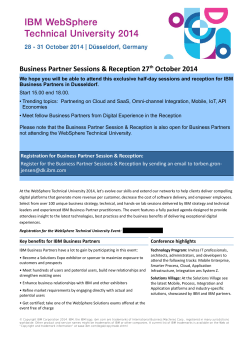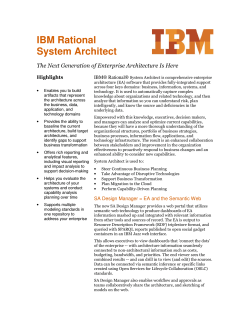
Guardium - kako obezbijediti sigurnost i kontrolu nad podacima Peter Pavkovič, IBM
Guardium - kako obezbijediti sigurnost i kontrolu nad podacima Peter Pavkovič, IBM peter.pavkovic@si.ibm.com © 2010 IBM Corporation Agenda Zašto sigurnost baza podataka Šta je to Guardium Guardium arhitektura Sažetak © 2010 IBM Corporation 3 Database Servers Are The Primary Source of Breached Data “Although much angst and security funding is given to offline data, mobile devices, and end-user systems, these assets are simply not a major point of compromise.” - 2009 Data Breach Investigations Report …up from 75% in 2009 2009 Data Breach Report from Verizon Business RISK Team Source: http://www.verizonbusiness.com/resources/security/reports/2009_databreach_rp.pdf Note: multi-vector breaches counted in multiple categories © 2010 IBM Corporation How are data breaches discovered? © 2010 IBM Corporation Database Activity Monitoring: Three Key Business Drivers 1. Prevent data breaches • Mitigate external and internal threats 2. Ensure data integrity • Prevent unauthorized changes to sensitive data 3. Reduce cost of compliance • Automate and centralize controls Across DBMS platforms and applications Across SOX, PCI, SAS70, … • Simplify processes © 2010 IBM Corporation Database Danger from Within “Organizations overlook the most imminent threat to their databases: authorized users.” (Dark Reading) “No one group seems to own database security … This is not a recipe for strong database security” … 63% depend primarily on manual processes.” (ESG) Most organizations (62%) cannot prevent super users from reading or tampering with sensitive information … most are unable to even detect such incidents … only 1 out of 4 believe their data assets are securely configured (Independent Oracle User Group). http://www.darkreading.com/database_security/security/app-security/showArticle.jhtml?articleID=220300753 http://www.guardium.com/index.php/landing/866/ © 2010 IBM Corporation The Compliance Mandate DDL = Data Definition Language (aka schema changes) DML = Data Manipulation Language (data value changes) DCL = Data Control Language © 2010 IBM Corporation Why is database auditing so challenging? 8 © 2010 IBM Corporation How are most databases audited today? Reliance on native audit logs within DBMS • Lacks visibility and granularity • Privileged users difficult to monitor • Tracing the “real user” of application is difficult • Level of audit detail is insufficient • Inefficient and costly • Impacts database performance • Large log files provide little value • Different methods for each DB type • No segregation of duties • DBAs manage monitoring system • Privileged users can bypass the system • Audit trail is unsecured © 2010 IBM Corporation Osnovne funkcionalnosti Guardium rješenja Pračenje aktivnosti u realnom vrjemenu (auditing) Zabrana internih/internetnih napada i gubljenje podataka Pračenje promjena na podatkovnoj bazi Zabrana/pračenje pristupa administratora podatkovnih baza Identifikacija prevara na aplikacijskom nivou Provjeravanje novih “patch”-ova na podatkovnim bazama “Data privacy accelerator” – unaprjed definirane politike, izvještaji, automtsko obavještavanje u realnom vrjemenu © 2010 IBM Corporation Real-Time Database Monitoring with InfoSphere Guardium Host-based Probes (S-TAPs) • • • Collector Non-invasive architecture – Outside database – Minimal performance impact (23%) – No DBMS or application changes Cross-DBMS solution 100% visibility including local DBA access • • • • Enforces separation of duties Does not rely on DBMS-resident logs that can easily be erased by attackers, rogue insiders Granular, real-time policies & auditing – Who, what, when, how Automated compliance reporting, signoffs & escalations (SOX, PCI, NIST, etc.) © 2010 IBM Corporation What does Guardium monitor? SQL Errors and failed logins DDL commands (Create/Drop/Alter Tables) SELECT queries DML commands (Insert, Update, Delete) DCL commands (Grant, Revoke) Procedural languages XML executed by database Returned results sets 12 © 2010 IBM Corporation Fine-Grained Policies with Real-Time Alerts Application Server 10.10.9.244 Database Server 10.10.9.56 © 2010 IBM Corporation Identifying Fraud at the Application Layer Marc Joe Issue: Application server uses generic service account to access DB – Doesn’t identify who initiated transaction (connection pooling) User Application Server 14 Database Server Solution: Guardium tracks access to application user associated with specific SQL commands – Out-of-the-box support for all major enterprise applications (Oracle EBS, PeopleSoft, SAP, Siebel, Business Objects, Cognos…) and custom applications (WebSphere….) © 2010 IBM Corporation Guardium u SAP okolini Upotreba za sve SAP module – SAP ERP, SAP CRM, SAP BI, ... Guardium ima poseban “plug-in” za SAP © 2010 IBM Corporation Data-Level Access Control: Blocking Without Inline Appliances “DBMS software does not protect data from administrators, so DBAs today have the ability to view or steal confidential data stored in a database.” Forrester, “Database Security: Market Overview,” Feb. 2009 Production Traffic Application Servers Privileged Users Issues SQL Outsourced DBA Connection terminated Datalevel Access Control Hold SQL Oracle, DB2, SQL Server, etc. Check Policy On Appliance Policy Violation: Drop Connection (or Quarantine User ) Session Terminated © 2010 IBM Corporation Vulnerability & Configuration Assessment Architecture Based on industry standards (DISA STIG & CIS Benchmark) Customizable – Via custom scripts, SQL queries, environment variables, etc. Combination of tests ensures comprehensive coverage: – Database settings – Operating system – Observed behavior DB Tier (Oracle, SQL Server, DB2, Informix, Sybase, MySQL) Database User Activity OS Tier (Windows, Solaris, AIX, HPUX, Linux) Tests • Permissions • Roles • Configurations • Versions • Custom tests • Configuration files • Environment variables • Registry settings • Custom tests © 2010 IBM Corporation Vulnerability Assessment Example Historical Progress or Regression Overall Score Detailed Scoring Matrix Filter control for easy use © 2010 IBM Corporation Broad Platform Support 19 Supported Platforms Supported Versions Oracle 8i, 9i, 10g (r1, r2), 11g, 11gR2 Oracle (ASO, SSL) 9i,10g (r1,r2), 11g Microsoft SQL Server 2000, 2003, 2008 Microsoft SharePoint 2007, 2010 IBM DB2 (Linux, Unix, Linux for System z) 9.1, 9.5, 9.7 IBM DB2 for z/OS 7, 8, 9 IBM DB2 (Windows) 9.1, 9.2, 9.5, 9.7 IBM DB2 for iSeries V5R2, V5R3, V5R4, V6R1 IBM Informix 7, 9, 10,11, 11.5 Oracle MySQL and MySQL Cluster 4.1, 5.0, 5.1 Sybase ASE 12, 15, 15.5 Sybase IQ 12.6, 15 Teradata 6.x, 12,13 Netezza 4.5 PostgreSQL 8 © 2010 IBM Corporation InfoSphere Security and Privacy Portfolio Discovery Encryption Expert Guardium Optim Test Data Management Optim Data Redaction Optim Data Privacy Solution © 2010 IBM Corporation Pitanja © 2010 IBM Corporation
© Copyright 2025





















